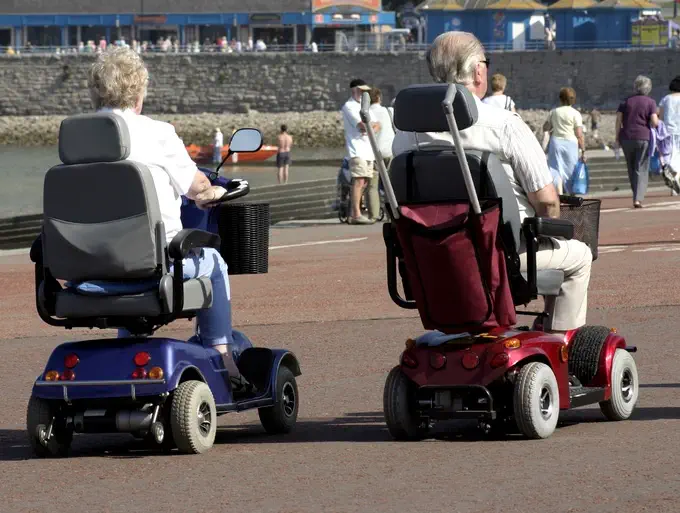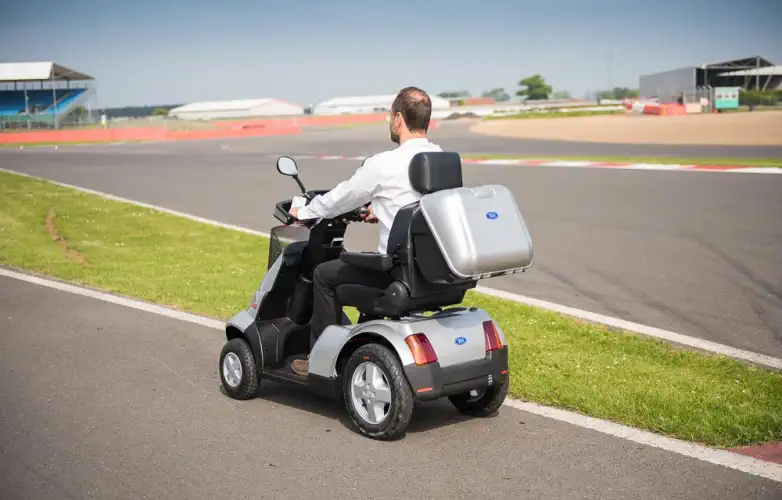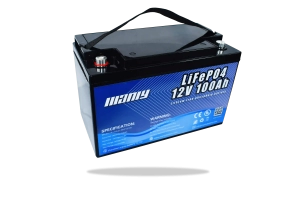Choosing the Best Mobility Scooter Lithium Battery
Table des matières
- Choosing the Best Mobility Scooter Lithium Battery
- The Best Type of Battery for Mobility Scooters
- How to Replace Battery in Mobility Scooter
- How Long Do Mobility Scooter Batteries Last
- Is Your Mobility Scooter Battery Draining Fast?
- Can You Leave a Mobility Scooter on Charge
- Mobility Scooter Battery Problems
- Understanding the Cost of Mobility Scooter Batteries
- Choosing MANLY 12V Lithium Batteries for Your Mobility Scooter
- The Best Battery Supplier for Lithium Battery Mobility Scooters

The Best Type of Battery for Mobility Scooters
Before we get into the exact model of battery necessary and the battery supplier you should get it from, we need to deal with the drawbacks of traditional lead-acid batteries.Technology has come a long way, and lead-acid has more or less become obsolete in terms of performance. It’s mostly still used because it’s cheaper to manufacture.If you’re looking to upgrade a mobility scooter battery or replace one that has kicked the bucket, you need to be looking at lithium batteries.Lithium had a bad reputation decades ago when lithium batteries first started hitting the market, but like most tech, that was due to initial problems needing to be sorted out. Now, they’re used for most devices, EVs, and plenty of other electronics.Lithium batteries are safer, last more than twice as long as lead-acid batteries, charge faster, and keep their charge for far longer.They’re the perfect upgrade for a mobility scooter, and you shouldn’t be looking at any other general type of battery. Any savings you get with another type are outweighed by the sheer performance of a high-quality lithium battery.Even if you have a lithium battery mobility scooter, it’s still a great idea to upgrade to a better model to ensure you or your loved one doesn’t get left without their scooter when they need it most.Voltage and Type of Battery to Look for
Most mobility scooters use a 12V battery. If you’re confused about the voltage of the battery you need, then you can simply look at the battery that’s currently in the scooter, and it will be labeled clearly. Just make sure the replacement you get matches the voltage rating of the one you’re replacing.Most mobility scooter batteries look a lot like car batteries and function pretty much the same way. There are no complicated hookups or wiring needs to worry about, and usually, there aren’t any proprietary plug connections to complicate matters.This makes upgrading your battery an extremely easy task. In the vast majority of situations, it’s just a drop-in solution. You take the old battery out, drop in the new one, and you’re ready to go.How to Replace Battery in Mobility Scooter
If you've observed that your mobility scooter is moving slowly or failing to hold a charge, it's time to consider replacing the batteries. Here's a guide on how to replace your mobility scooter battery:- Choose an Appropriate Workspace: Select a dry and level area, ideally like a garage floor, to perform the battery replacement.
- Locate the Battery Compartment: Identify the battery compartment's location, typically situated beneath the scooter's seat.
- Deal with Nut and Bolt Terminals: Mobility scooter batteries often feature nut and bolt terminals. You'll require a wrench to loosen these connectors.
- Disconnect the Terminals: Start by disconnecting the negative (black) terminal first, followed by the positive (red) terminal.
- Remove the Old Batteries: Batteries can be quite heavy, so don't hesitate to seek assistance if needed while removing them.
- Install the New Batteries: Carefully insert the new batteries into place. Attach the positive (red) terminal first, and then secure the negative (black) terminal. Ensure the connections are tight by using a wrench.
- Seal the Battery Compartment: Close the battery compartment securely and replace any other components that were disassembled during the process.
- Eco-Friendly Disposal: Don't forget to responsibly recycle the old battery to minimize environmental impact.

How Long Do Mobility Scooter Batteries Last
So, you've got a new mobility scooter or maybe you're thinking about getting one. The big question on your mind might be: "How long will the battery last?" Let's dive into this!1. The Warranty Period Almost all mobility scooters come with a warranty for the battery, usually around 12 months. This means that if your battery starts acting up within the first year, you might be covered. Always check the details in your warranty, so you're prepared if something happens.2. Charge It Right How you charge the battery matters a lot. The guidebook that comes with your scooter will tell you how long to charge it. Most times, it's about 8 hours. And don't leave it charging all the time! Overcharging can harm the battery. It's like eating too much candy; a little is fun, but too much is bad for you.3. Store It Safe When you're not zipping around on your scooter, think about where it's kept. Really hot or really cold places aren't great for the battery. And if it's charging, make sure it has space around it because the battery can get warm. It's like how we need space to breathe; batteries do too.4. Plan Ahead Even with the best care, batteries don't last forever. Most scooter batteries will keep going strong for about 18 to 24 months. Some can even reach up to three years if you treat them super well. But it's smart to think about getting a new one every 18 months or so. If your scooter starts moving slow or the battery isn't lasting as long, it might be time for a change.In short, with a little care and attention, scooter batteries can last a good long while. And when you're ready to get a new one, remember to recycle the old battery. It's a small step that helps our planet.Is Your Mobility Scooter Battery Draining Fast?
Aging Battery Batteries possess a finite lifespan, and their durability hinges on usage frequency. Generally, batteries endure for approximately 18 months. An aging battery exhibits reduced capacity compared to a fresh one, necessitating replacement. Ponder acquiring a new battery or an enhanced, higher-capacity model. When procuring a replacement battery, provide the serial or model number of your mobility scooter to guarantee compatibility.Incorrect Charging Human error frequently contributes to swift battery depletion. Incorrectly plugging in the device can lead to zero charging. Ensure secure connections both on the device and the power outlet when charging. The charger's compatibility with your specific mobility scooter is crucial. Avoid substituting chargers, even if the connectors seem to fit snugly, as varying wattages may lead to overcharging or insufficient charging.Inadequately Inflated Tires Battery performance relies on optimal conditions, which includes well-maintained tires. Insufficiently inflated tires demand more energy from the battery to propel the scooter. Even on smooth surfaces, improperly inflated tires force the battery to exert unnecessary effort. Maintain the correct tire pressure in accordance with the PSI (pounds per square inch) indicated on each tire or within the owner's manual. If your tires lose air frequently, inspect for potential punctures by sharp objects or contemplate upgrading to new tires. Most mobility scooters recommend tire replacement every 5 to 6 years.Challenging Terrain Operating your mobility scooter on rough terrain will deplete the battery more rapidly. Navigating inclines and rocky surfaces requires the device to work harder, increasing energy consumption. Most mobility scooters possess an incline rating, exceeding which can hasten battery drain. All-terrain mobility scooters feature enhanced motor and battery capacities to cope with diverse terrains.Standard mobility devices lack this capability, so if you are an active user in challenging environments, investing in a high-end, all-terrain model is advisable. Monitor your battery's range even with an all-terrain scooter and upgrade as needed.Weather-Related Factors Weather exerts a considerable influence on mobility scooter performance. Battery drainage is accelerated during wet and chilly conditions. Colder weather slows down the chemical reactions within the battery responsible for charging and maintaining power. Additionally, rainy weather can swiftly deplete the battery, with water infiltration impairing performance.Most mobility scooters possess some level of water resistance, but excessive rain can hamper operation. To mitigate this, consider acquiring a cover for your mobility scooter, as many models come equipped with either hard or soft covers to shield against rain and wind.Exceeding Weight Capacity Mobility scooters come with weight limits for valid reasons. They are engineered to support specific weights without compromising their systems. Exceeding the weight limit will cause rapid battery drain and impair device performance. Verify that your mobility scooter is designed for your weight and refrain from surpassing its limits.Should you notice a decrease in your battery's range, contemplate upgrading to a more potent battery. Regular maintenance of your mobility device, especially the battery system, will extend its lifespan. Neglecting maintenance can potentially void warranties and accelerate component wear and tear.Can You Leave a Mobility Scooter on Charge
So you're diving into the world of mobility scooters, and you're wondering about the heart of the scooter – its battery. Let's break down how to keep your scooter's battery healthy and lasting long.1. Charging Your Scooter: Step-by-Step Guide- First, make sure your mobility scooter or power chair is off. This could mean turning a key, pushing a button, or flipping a switch.
- Next, plug the charging socket into your scooter. Where you'll find this spot varies, but for bigger scooters, it's often by your knees. On compact scooters, it might be near the feet or the back. Power chairs typically have their charging plugs under the joystick.
- Connect the charger to a power source. Remember to turn on the power if you have a switch.
- Look out for the little lights on your battery or charger. If it’s red or orange, it means the battery is charging. Charging can take between 6 to 10 hours, depending on your scooter and battery type. Wait for it to turn green, which signals a full charge.
- Once charged, first unplug the charger from the scooter, then from the power source.
- Do know your battery type. It could be sealed, gel or lithium battery.
- Don't keep your scooter plugged in all the time after it’s fully charged. This can hurt the battery in the long run.
- Do fully charge your batteries at least 24 hours before using your scooter.
- Don't use your scooter without a full charge.
- Do check the battery gauge to know its charge status.
- Charge your scooter after every trip and let it charge overnight.
- If your battery gauge is only showing red LEDs, stop driving! This can harm the battery’s life and performance.
- For scooters not used daily, make sure you charge them at least once a month.
- Worried about overcharging? If you're using the charger that came with your scooter, it should prevent overcharging. So you can leave it connected without worries.
Mobility Scooter Battery Problems
Mobility scooters have revolutionized transportation for many, offering independence and ease of movement. However, like any electronic device, they can face issues, primarily with their batteries. Let’s dive into common battery problems and ways to address them.1. Recognizing the Problem Mobility scooters rely heavily on batteries, and several signs indicate a battery issue:- Decreased Charge Capacity: Regular usage can reduce the battery’s capacity.
- Battery Warning Lights: Keep an eye on your scooter's battery indicator.
- Inability to Hold Charge: If your scooter doesn’t power up after a full charge, it’s a clear sign of battery problems.
- Wear and Tear: Every battery has a lifecycle. Most batteries can undergo about 500 recharge cycles before their efficiency decreases.
- Faulty Charging Port: If your battery seems healthy but isn’t charging, the charging port or its connectors might be at fault. Always ensure the wires are securely connected.
- Water Damage: Water is a battery's enemy. Whether it's rain or accidentally driving through puddles, moisture can damage the battery or other components.
- Faulty Charger: A malfunctioning charger can be the culprit behind your battery woes. Always ensure you're using the appropriate charger for your scooter.
- Check the Charger: If your scooter doesn’t charge, try using the charger with another device. If it doesn't work there either, you might need a new charger.
- Inspect the Charging Port: Look for loose wires or any visible damage. But always remember, safety first! Ensure the scooter is switched off, and you’re not connected to an electrical outlet.
- Test the Battery: Using a multimeter, check the battery voltage to ensure it’s charging correctly.
- Avoid Water: As tempting as it might be, avoid using the scooter during rainy conditions or in areas with deep puddles.
- Complex Issues: Problems related to the motor, loose internal wires, or the battery pack can be intricate and require specialized knowledge.
- Safety Concerns: Batteries contain chemicals. Any leaks or damages can pose a safety hazard, especially if acid is involved.
- Peace of Mind: Professionals have the tools and expertise to diagnose and fix the problem correctly.
Understanding the Cost of Mobility Scooter Batteries
Mobility scooters empower countless individuals with improved independence, but maintaining them can sometimes come with a cost—particularly when it concerns the batteries. If you've ever wondered why mobility scooter batteries can be on the pricier side, you're not alone. Let’s delve into the reasons behind their price tags.Different Batteries, Different Costs:- Sealed Lead Acid (SLA) Batteries: The SLA batteries are the most budget-friendly option available for mobility scooters. However, the catch is in their durability. Typically, SLA batteries have a lifespan and warranty that stretches only up to 12 months. This means users may find themselves replacing these batteries annually.
- Gel Mobility Scooter Batteries: These batteries carry a higher price tag compared to SLA batteries. The reason? They offer a more extended lifespan, usually ranging from 18 to 24 months. This greater durability justifies the higher cost. They can also be recharged more frequently, which means they can serve the user longer before needing a replacement.
- Lithium Batteries: The crème de la crème of mobility scooter batteries! Lithium batteries, especially brands like MANLY Lithium Battery, have the steepest initial cost but prove to be the most cost-effective in the long run. How? These batteries can last a whopping 10 times longer than SLA batteries. They are lightweight, offer enhanced performance, and can provide 2 to 3 times the battery range of their counterparts. What's even more enticing is the generous 10-year warranty offered by brands like MANLY. So, while you might feel the pinch while purchasing, the longevity and performance make it worth every penny.




















